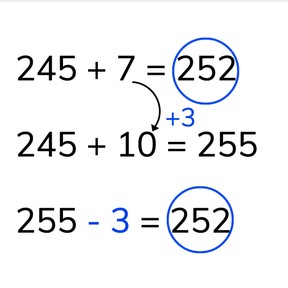



8,000 schools use Gynzy
92,000 teachers use Gynzy
1,600,000 students use Gynzy
General
Students learn to add to 1,000 by using the compensation method. That is by adding ones or tens to an addend to make a round number to use in calculation, and then to take away the added ones or tens to find the total.
Common core standard(s)
2.NBT.B.7
Relevance
It is useful to learn this so you can add addition problems up to 1,000 easier and quicker.
Introduction
Explain that hundreds are a group of 100 and have zeroes in the tens and ones places, they are round numbers. Ask students if they can name any hundreds. Next ask students to practice rounding to a hundreds number. The interactive whiteboard shows rain droplets with random numbers. Have students draw a line from a number to its closest round hundred number. 98 to 100, 199 to 200, etc.
Development
Tell students that you can solve addition problems to 1,000 in different ways using the compensation method. First explain how to use tens. With the problem 245+7, you first round up to 10 with your ones. This is your compensation step. Solve for the total, but then you have to take away what you added. The total remains the same. Have students complete the addition problems in which they round the second addend to 10. Then explain to students that the compensation method also works with hundreds. With the problem 595+60 you round the tens number to the next hundred. The next steps (find the total of the compensation step, take away what you added) are exactly the same as with rounding to 10. Ask students to solve a few addition problems in which they round the tens to the next hundred. Finally explain to students that you can also use the compensation method on hundreds. You look to see which addend is closest to a hundred and then you round to the closest hundred and follow the same steps as for with ones and tens. Check that students know which compensation step to take by asking them to match the compensation steps to some given addition problems. You can erase the grey squares to show the answers. Show the number line to help students visualize which number is closest to the next hundred.
Check that students are able to use the compensation method in adding to 1,000 by asking the following questions:
- What ways can you use the compensation method in adding to 1,000? (with 10s, with 100s, or hundreds)
- Round the following numbers to their nearest hundreds: 296-402-799-598-601
- How can you best solve 891+70? (using 100s)
- Which step can you not forget when using the compensation method? (to take away what you added)
Guided practice
Students first practice using the compensation strategy with 10s, then with 100s, and finally with hundreds.
Closing
Ask students to determine which compensation step needs to be dragged to the blue box. Ask them why they think this is the correct compensation step. Discuss why it is easier to make the addition problem easier using the compensation method. Point out that they always have to remember to take away the extra that they added to the addition problem to get the correct answer.
Teaching tips
For students who have difficulty with this, it is easy to make this visible using MAB blocks. They can see (using different colored blocks) what they are adding, and what they need to take away at the end. They can also be supported by writing out each step of the process, so they don't forget any steps.
Instruction materials
MAB-blocks
The online teaching platform for interactive whiteboards and displays in schools
Save time building lessons
Manage the classroom more efficiently
Increase student engagement
Discover more!
About Gynzy
Gynzy is an online teaching platform for interactive whiteboards and displays in schools.
With a focus on elementary education, Gynzy’s Whiteboard, digital tools, and activities make it easy for teachers to save time building lessons, increase student engagement, and make classroom management more efficient.



